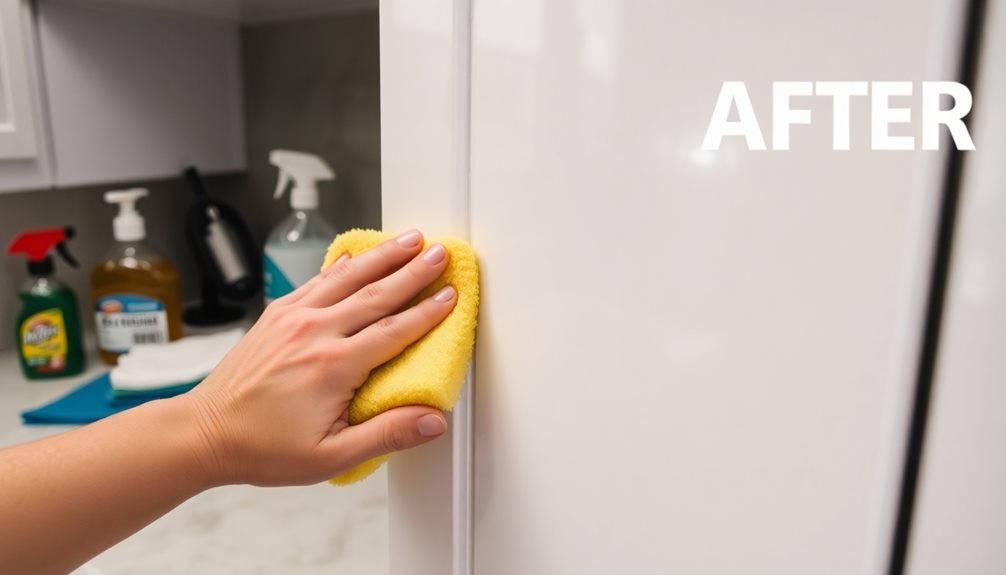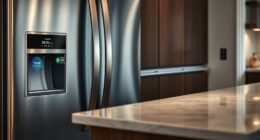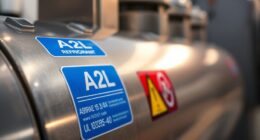You can't afford to miss these essential refrigerator and freezer repair tips! Start by checking that your fridge is plugged in and that the outlet works. Inspect door seals for any damage, and clean condenser coils every few months to boost efficiency. If your ice maker's acting up, look for kinks in the water lines. Adjust your temperature controls to keep food safe. If you notice unusual noises or leaks, address them promptly to avoid costly repairs later. Want to discover even more effective tips and tricks for maintaining your appliance? Keep exploring the options!
Key Takeaways
- Regularly clean condenser coils every 2-3 months to prevent cooling failures and enhance energy efficiency.
- Check and replace door seals quarterly to maintain proper temperature and reduce energy loss.
- Monitor and adjust temperature settings to 37-41°F for the fridge and 0°F for the freezer for optimal food preservation.
- Inspect and clear any blockages in the drainage system to prevent water leaks and ice buildup.
- Perform simple DIY repairs, like replacing water filters and checking for kinks in supply lines, to save on costly repairs.
Common Refrigerator Problems
When it comes to common refrigerator problems, you're likely to encounter issues that affect cooling efficiency. Cooling failures can arise from frost buildup on evaporator coils or compressor issues, leading to temperature inconsistencies inside.
If you notice your ice maker's not working, it could be due to blocked water supply lines or faulty water inlet valves, which stops ice production altogether. Water leaks are another frequent nuisance, often caused by damaged door gaskets, clogged defrost drains, or problems with the water supply line.
You might also hear excessive noise from your fridge, which could indicate malfunctioning components like the compressor or condenser fan motor. Addressing these problems promptly is essential.
Additionally, don't overlook the importance of regular maintenance; dirty condenser coils can obstruct airflow and contribute to cooling failures. Make it a habit to inspect air vents for any obstructions and verify your thermostat settings are correct.
Essential Troubleshooting Techniques
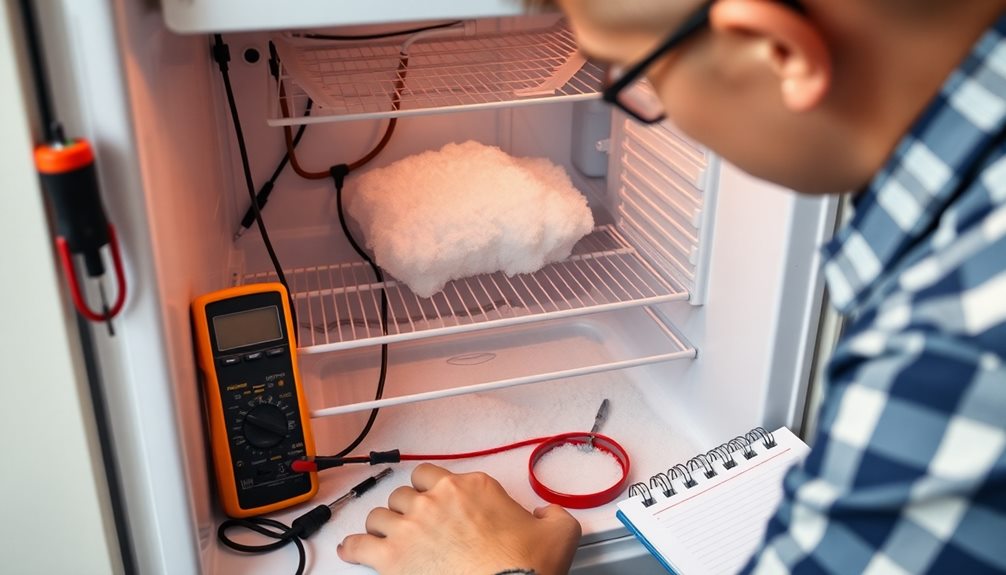
Addressing common refrigerator problems requires a systematic approach to troubleshooting. Start by checking if your refrigerator is plugged in and confirm the outlet has power. Adjust the temperature control to the ideal range of 37-41°F for effective cooling.
Next, inspect the door seals for any damage or dirt; compromised seals can lead to temperature fluctuations and increased energy consumption due to cold air escaping.
Regularly clean the coils located at the back or bottom of the refrigerator every 2-3 months. Dust accumulation can greatly hinder cooling efficiency.
If you notice frost buildup inside the freezer compartment, it might block airflow and indicate issues with the defrost system. Persistent frost should prompt a professional evaluation.
For further troubleshooting, utilize a multimeter to test essential electrical components like the thermostat, compressor, and defrost heater. This will help isolate the source of your refrigerator's cooling problems.
DIY Repair Steps
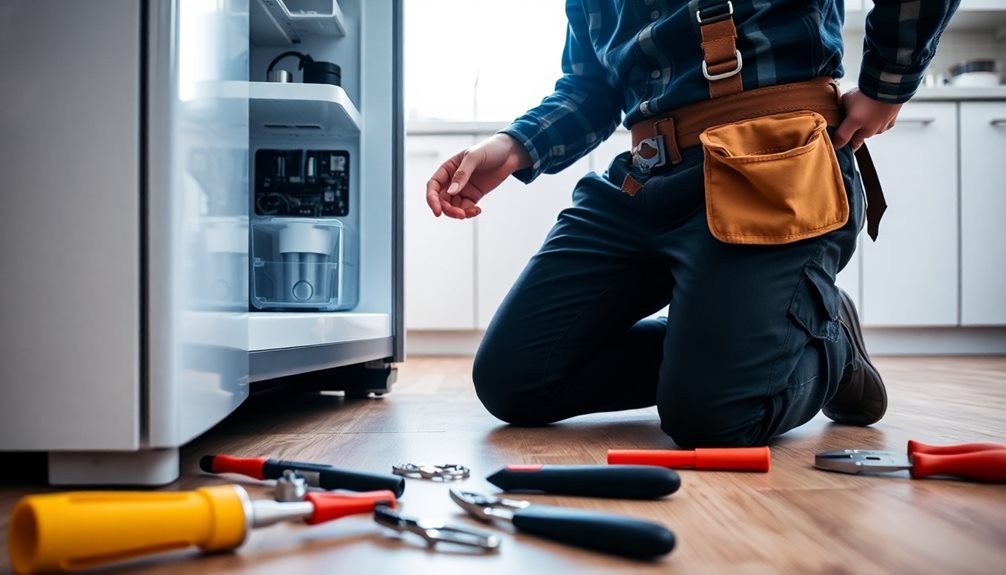
Sometimes, tackling DIY repairs on your refrigerator can seem intimidating, but with the right approach, you can resolve many common issues yourself. First, always unplug your fridge before starting any repairs to guarantee safety.
Regularly clean the condenser coils every 2-3 months; this helps maintain efficient cooling and prevents performance issues.
If you're facing temperature problems, check the temperature settings. Adjust the thermostat to the recommended range of 37-41°F for the fridge and 0°F for the freezer.
For ice buildup in the freezer, use a hair dryer on a low setting to carefully melt the ice, and don't forget to inspect the drain hole for blockages that might need clearing.
If your Ice Maker isn't functioning, examine the water supply lines for kinks or obstructions. Make sure the water inlet valve is fully open to restore proper flow.
When to Seek Professional Help
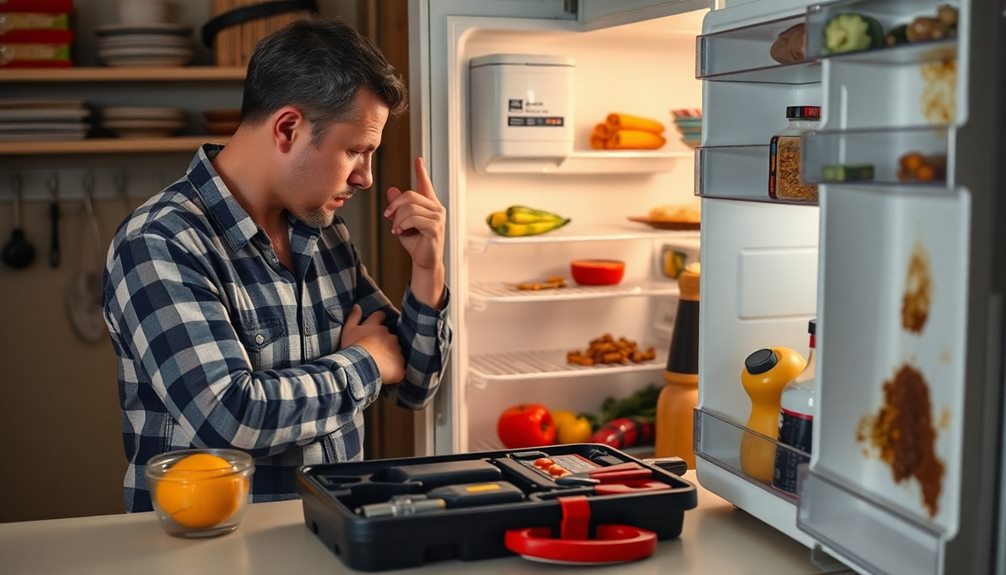
Knowing when to seek professional help for refrigerator repairs can save you time, money, and hassle. If your fridge experiences persistent cooling failures despite your DIY troubleshooting efforts, it may indicate a complex issue requiring a professional evaluation.
Unusual noises like grinding or clicking from the compressor are also signs of mechanical problems that typically necessitate a technician's expertise for safe and effective repairs.
If your appliance is over 15 years old and showing significant malfunctions, professional repair might be more cost-effective than extensive repairs or replacement. Complex electrical issues or critical component failures, such as a malfunctioning thermostat or compressor, often require specialized knowledge and tools that only a professional can provide.
When you've made multiple attempts to fix common problems—like leaks or excessive frost buildup—and nothing works, it's time to seek professional assistance. Doing so can prevent further damage and potential food spoilage.
Trust your instincts; if a problem seems beyond your skill level, don't hesitate to call in the experts. They can guarantee your refrigerator operates efficiently and safely, protecting your investment and your groceries.
Maintenance Tips for Longevity
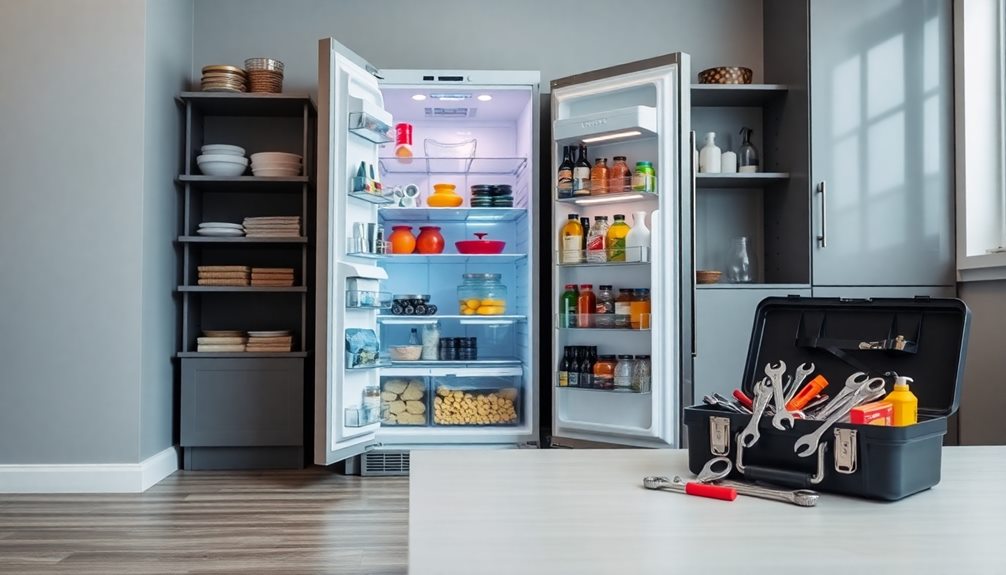
Maintaining your refrigerator is key to guaranteeing it runs efficiently and lasts for years. By following a few simple maintenance tips, you can keep your appliance in top shape and avoid costly repairs down the line.
- Clean the coils: Every 2-3 months, unplug your refrigerator and clean the condenser coils to prevent dust accumulation. This step is essential for maintaining cooling efficiency and lowering energy consumption.
- Inspect and replace the water filter: Change your water filter every 3-9 months to guarantee a clean water supply for your ice maker and water dispenser. This will also help in maintaining peak functioning.
- Monitor the temperature: Keep your refrigerator between 35°F to 38°F (1.6°C to 3.3°C). Regularly check this setting to guarantee your food stays fresh and safe to eat.
Additionally, clean the door gaskets quarterly to maintain a proper seal and schedule a thorough cleaning and defrosting of the freezer at least once a year.
With these simple yet effective maintenance routines, you'll enhance your refrigerator's longevity and performance.
Understanding Repair Costs
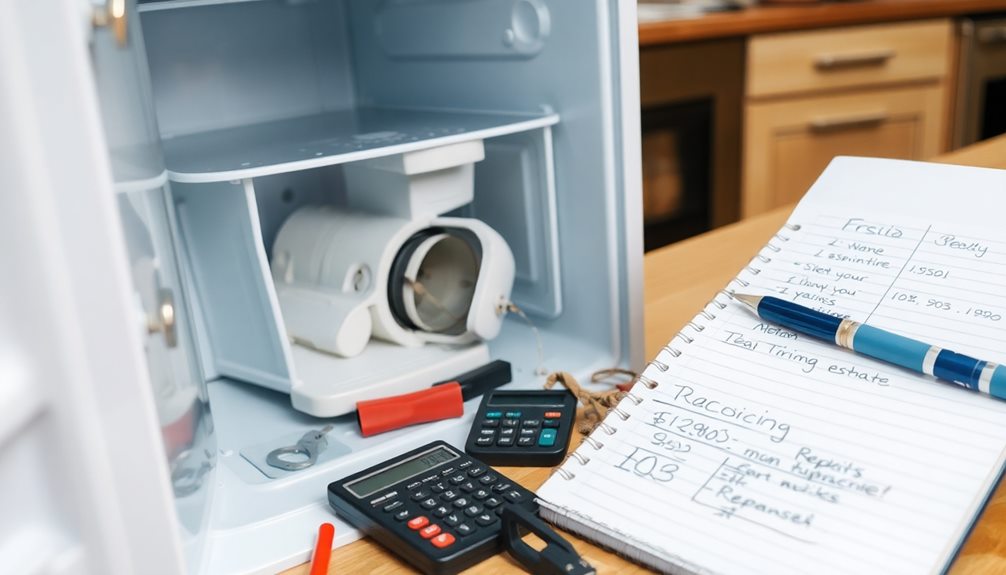
When it comes to understanding repair costs for your refrigerator, you'll find that average expenses usually fall between $200 and $330, depending on the issue.
Common problems, like ice maker malfunctions, often have affordable parts, allowing for some DIY savings.
However, for more complicated repairs, it might be worth hiring a professional, which can drive up your total costs.
Average Repair Costs
Understanding average repair costs for your refrigerator can help you budget effectively and make informed decisions. Typically, you can expect to pay between $200 and $330 for various issues.
Here are three common repairs you might encounter:
- Replacing door gaskets – This simple fix can help improve your fridge's efficiency.
- Cleaning condenser coils – An easy maintenance task that can prevent larger issues.
- Repairing critical components – More complex repairs, like fixing compressors, usually require professional evaluation and can be expensive.
While DIY repairs can save you money, consider the cost of parts and tools versus professional service fees.
Regular maintenance is key to minimizing repair costs in the long run. By addressing common fridge issues promptly, you can keep your refrigerator running smoothly.
Common Issues Impacting Prices
Repair costs for refrigerators can vary widely based on several common issues that arise. For example, cooling failure is a frequent problem that can lead to average repair costs ranging from $200 to $330. Understanding the underlying principles of the refrigeration cycle can help in diagnosing issues more effectively.
If your ice maker isn't functioning or there's a water supply issue, these repairs could also add to your expenses. The complexity of the problem plays a significant role, with simple fixes like cleaning condenser coils or changing a water filter being relatively inexpensive.
On the other hand, if you're facing more complicated repairs—like a faulty compressor or circuit board—you might see your costs skyrocket. While DIY repairs can cut down on expenses, it's essential to know when to call for professional service, especially for electrical issues or ongoing problems.
Regular maintenance can help you avoid these common issues altogether, extending your refrigerator's lifespan and reducing the chances of costly repairs in the future. By staying proactive, you can manage repair costs effectively and keep your appliance running smoothly.
DIY Savings Opportunities
Many homeowners overlook the potential for significant savings by tackling simple refrigerator repairs themselves. Understanding repair costs can lead to impressive DIY savings, especially when you can address issues before they escalate.
Regular maintenance tasks, much like cleaning your best pizza stones for RV ovens, can also enhance the efficiency of your appliances. With basic tools for repairs, you can keep your fridge running smoothly and guarantee your food stays cold without breaking the bank.
Here are three easy DIY tasks that can save you money:
- Cleaning condenser coils – This simple routine maintenance task can improve efficiency and prevent costly cooling failures.
- Replacing common replacement parts – Items like door seals and water filters are inexpensive and easy to find, making repairs quick and affordable.
- Identifying issues early – Knowing how to troubleshoot basic problems can help you catch small issues before they turn into expensive repairs.
Frequently Asked Questions
What Is the Most Expensive Thing to Fix on a Refrigerator?
The most expensive repair you'll face on a refrigerator is usually the compressor replacement, costing between $300 and $600. Sealed system repairs can exceed $1,000, making them even pricier and more complex to fix.
Is It Worth Getting a Fridge Freezer Repair?
Yes, it's often worth getting a fridge freezer repair, especially if it's under 15 years old. Simple fixes can save you money and extend its life, making repairs more cost-effective than buying a new appliance.
How Much Does It Cost to Fix a Freezer That Will Not Freeze?
Oh, the joys of a freezer that won't freeze! Expect to shell out $200 to $330 for repairs. Consider simple DIY fixes first, but if it's ancient, replacing might be more sensible—and less frosty!
What Is the Most Common Repair on a Refrigerator?
The most common refrigerator repair involves fixing cooling issues, often caused by frost buildup on evaporator coils. Regular maintenance can help you avoid such problems, ensuring your appliance operates efficiently and lasts longer.
Conclusion
In the world of refrigerator repair, a little knowledge goes a long way. By tackling common issues and knowing when to call in the pros, you can keep your appliance running smoothly. Remember, just like a well-stocked fridge, staying on top of maintenance guarantees you won't face a crisis when you least expect it. So, take these tips to heart, and let your fridge serve you well for years to come!



